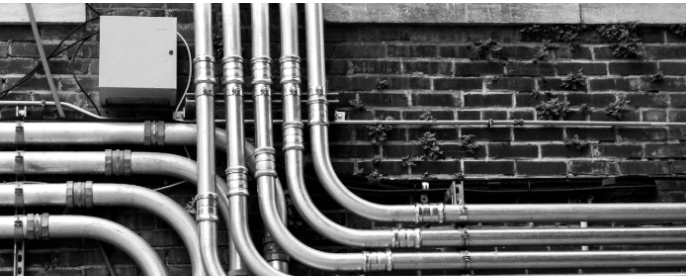With large structures such as commercial buildings, identifying pipe bursts is an important area that needs immediate attention since a single incident may cause major damage, expensive repairs. Compared to residential properties, commercial buildings have extended pipe networks in varied areas, making identifying and repairing the affected area difficult. This article identifies the factors that define pipe bursts and the challenges in detecting and preventing risk factors.

Common Signs of Pipe Bursts in Commercial Properties
A pipe burst might not always be immediately visible, but these signs can help identify the issue:
- Unexplained Water Bills: High water bills are usually accompanied by signs of concealed leakage or even a burst water pipe.
- Water Pressure Issues: Low or inconsistent water pressure across faucets and fixtures can change the chance of a broken pipe or pipe burst.
- Visible Water Damage: Wet marks on the ceiling, wall or floor might suggest that the leak results from a bursting pipe.
- Mold and Mildew Growth: Damp conditions created by a pipe burst often lead to mould and mildew, which can be hazardous to health.
- Audible Clues: Sounds of running water or dripping in walls or ceilings, even when fixtures are off, indicate a pipe issue.
- Standing Water: Puddles in areas that should remain dry, such as basements, hallways, or utility rooms, may indicate a burst.
For accurate detection and timely repair of pipe bursts in commercial properties, it is highly recommended to consult with experienced plumber Kingston. Superior Plumbing and Heating provides expert pipe problem detection services using advanced technology: pipe repair, new pipe installation, and maintenance assistance.
Challenges of Detecting Pipe Bursts in Commercial Buildings
Commercial buildings present several unique challenges when it comes to detecting pipe bursts. The large-scale infrastructure of these buildings often involves extensive plumbing systems, making it difficult to locate a single issue. With multiple water lines serving various tenants or operational zones, pinpointing the exact location of a problem requires a thorough investigation. Additionally, many pipes are concealed within walls, ceilings, or underground, increasing the detection complexity.
In busy commercial settings, the constant noise and activity levels can cause the sound of running water or leaks to go unnoticed. Aging infrastructure is another concern, as older commercial properties may have outdated pipes more prone to bursting due to corrosion or wear. However, dedicated water lines in buildings like restaurants, or hospitals, high pressure systems, or unusual water supplies make matters worse regarding plumbing problems.
Causes of Pipe Bursts in Commercial Properties
It is crucial to comprehend the causes of frequent pipe bursts to prevent them and respond to them quickly. One significant cause is freezing temperatures; either in winter if the climate is freezing and pipes lacking insulation undergo the freezing and expansion leading to bursting. The other problem is corrosion whereby pipes made out of metal corrode over time because of rusting and this makes them vulnerable to breakage. High water pressure also represents a threat because high-pressure stress puts a strain on the pipe, it may crack or burst. Naturally, tree root intrusion becomes a severe problem in outdoor systems; the roots get into and obstruct the pipes and burst them.
Regular bursts occur when poor installation practices are used; other than that, using inferior materials, or bad artistry weakens some areas and causes bursts after some time. In industrial environments, plants and equipment may pose risk to adjacent pipes, shaking and loading from machinery resulting in pipe failure and subsequent leakage. When dealing with plumbing systems in your home, it’s important to understand the impact of pipe placement, especially when it comes to sewer line installation, as improper positioning can lead to costly repairs and system inefficiencies.
Steps to Detect and Address Pipe Bursts
Monitor Water Usage: This can be done through installing water meters or monitoring systems to notice wet and dry bumps that are usually detected on water consumption.
Conduct Regular Inspections: The help of a specialist in plumbing is needed to conduct a thorough inspection of possible problems with the pipes in the house at least once in a while.
Use Advanced Detection Technology: Through the use of infrared cameras, acoustic sensors and pressure tests the experts are able to detect concealed leaks and bursts.
Train Maintenance Staff: Equip staff with the knowledge to quickly identify and respond to potential pipe issues.
Address Complaints Promptly: Pay attention to tenant or employee reports of water issues, such as pressure drops or unusual noises.
Real-Life Examples of Pipe Bursts in Commercial Properties
- Office Complexes: An unnoticed pipe burst in an office ceiling can disrupt operations, damage IT equipment, and lead to costly repairs.
- Restaurants: A burst pipe in a kitchen can halt service, compromise hygiene standards, and damage expensive appliances.
- Hospitals: In healthcare facilities, pipe bursts can compromise sanitation, affect patient care, and require immediate resolution.
- Retail Stores: Leaks in storage or display areas can damage merchandise, impacting sales and revenue.
- Hotels: Burst pipes in guest rooms or common areas can lead to guest complaints, refunds, and reputational damage.
Conclusion
Detecting pipe bursts in commercial properties requires vigilance, advanced tools, and proactive measures. Property managers can minimize the impact of plumbing emergencies by recognizing the signs, understanding the challenges, and addressing the causes. Regular maintenance and investment in modern technology ensure that commercial plumbing systems remain efficient and resilient, protecting the property and its occupants from costly disruptions.











